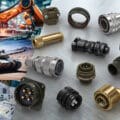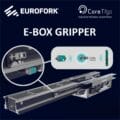~ Sensors that only need the most miniscule amount of power ~
Researchers at the Massachusetts Institute of Technology (MIT) have recently developed a temperature sensor that can harvest and store the energy from the magnetic field that exists in the open air around a wire. As a result, this could allow sensors to operate in the most remote settings and — importantly — without batteries. Here, Tom Cash, director of automation parts supplier, Foxmere, explains how energy harvesting sensors can improve maintenance and tackle a certain environmental issue.
When electricity flows through a wire, it generates a magnetic field. MIT’s latest sensor design harvests energy from that field, much like a transformer capturing inductive power. The energy is then stored within the sensor to power its operations.
To start the sensor without any initial voltage, the researchers at MIT designed a network of integrated circuits and transistors that store energy until there’s enough to turn on the sensor.
This process, which uses capacitors, is called a “cold start” and it lets the sensor power itself autonomously.
Capacitors are used to store the harvested energy because they are large enough to provide the initial burst of energy required to power up the device, while still being small enough to charge quickly.
After the cold start, the sensor will continue to harvest energy to stay active, using control algorithms to manage its power usage efficiently, making it ideal for maintenance and waste limitation.
Maintenance made easy
Machinery is an obvious source of energy. In fact, most machinery with moving parts and equipment incorporating electric motors are ideal for harvesting energy.
Sensors, such as MIT’s temperature-sensing device, can be clipped around the wire that’s carrying electricity — like one that powers a motor — to capture and store energy from the surrounding magnetic field.
The harvested energy can then be used to power the sensor’s operations, enabling it to monitor the motor’s temperature and report back, indefinitely.
This capability makes it useful for complex industrial applications and for hard-to-reach locations, such as deep inside a ship’s engine, where sensors cannot be quickly shut down for maintenance.

Reducing environmental waste
Although batteries have been a reliable source of power for decades, their environmental impact is becoming increasingly problematic.
While recycling batteries is one way to mitigate their environmental impact, it can be complex and expensive due to batteries containing harmful materials, including heavy metals and toxic chemicals.
As a result, worldwide battery recycling rates vary widely and are inconsistent, to say the least. In fact, according to the European Commission, less than half (48 per cent) of the portable batteries and accumulators sold in the EU were collected for recycling in 2021.
What’s more, there are approximately 17.08 billion connected IoT devices today, with 78 million batteries that power IoT devices to be dumped globally — every day — by 2025, as revealed by CORDIS.
It’s less than ideal. But this is where smart, energy efficient technology comes into play, such as energy harvesting sensors. Effectively, these sensors operate as a standalone piece of equipment and can be attached to many varieties of machinery.
For plant managers wanting to transition to sensors of this type, a reliable and trusted automation parts supplier will be required. If you would like assistance in finding the right hardware for your application, please get in touch via the Foxmere website.








